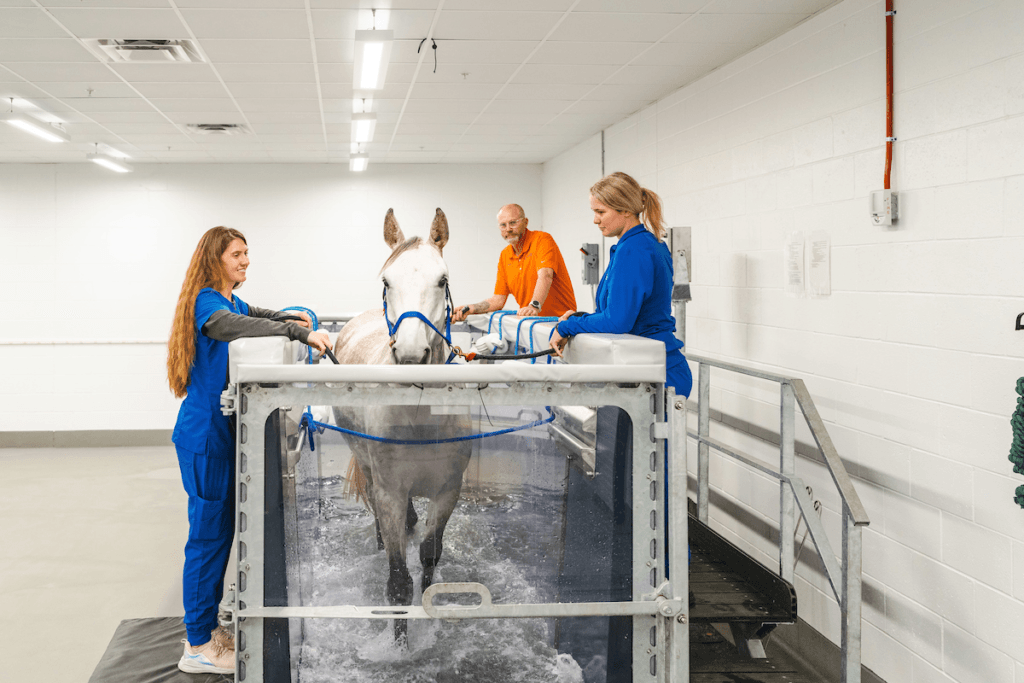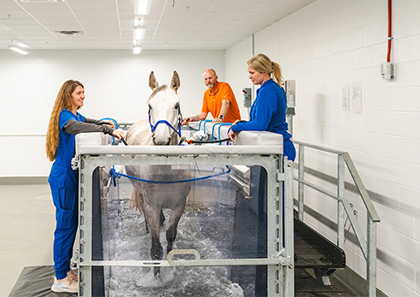
By: UF Veterinary Hospital at WEC
In the last several years, the popularity of using aqua treadmills for health and fitness has increased, becoming more common than swimming. Aqua therapy exploits the properties of water to improve musculoskeletal function.
How does aqua treadmill therapy exert an influence on the equine athlete?
The water properties of interest employed in this therapy include buoyancy, resistance, hydrostatic pressure and temperature. Buoyancy relates to a force acting against gravity and results in a decrease in the amount of load or ground reaction force placed on tendons, joints and bones. Water at the level of the hock decreases ground reaction forces by approximately 10%, while at the stifle decreases it by 15%. Water is also roughly 12 times denser than air, creating resistance that improves strength and motor control of muscles and promotes joint stability. Another effect water achieves on muscle is hydrostatic pressure. This circumferential compression on distal limbs increases blood flow to musculature and lymphatic drainage, which decreases edema. Lastly, the temperature of the water is exploited with cold water being chosen for decreasing inflammation and pain, while warm water is for pain and muscle spasms and to increase cardiac load.
How does the equine athlete benefit from aqua treadmill therapy?
Aqua treadmill therapy allows for targeted rehabilitation therapy or conditioning. Water height can be controlled, and the targeted area of concern will determine that height. When the water is at the fetlock, there is an increase in range of motion of the fetlock, when the water is raised to the hock then the range of motion of the fetlock and carpus increase, and when it reaches the stifle, the hock’s range of motion increases. Water depth also affects the core and back motion resulting in activation of core and back musculature. Think about walking in water, you try to lift your feet above water to a certain height and then you begin to push through the water. This is the same effect that water height within the aqua treadmill has on horse movement.
Speed can also be controlled, which translates to controlled exercise for the horse with a sports injury and a method of anerobic exercise for those horses looking for an additional avenue for conditioning. The treadmill option also helps horses to achieve symmetrical gait and anecdotally, riders report that their horse moves straighter under tack. Speed also has an effect on the amount of resistance the horse encounters and increasing the workload on the major muscle groups especially when the water height is at the stifle.
Overall, aqua treadmill therapy provides an alternative to controlled exercise for those horses recovering from a sport injury or for those horses that need adjunct to their current conditioning program. This therapy allows for the creation of an individualized program for your horse’s current needs. Horses adapt within 2-3 sessions to the movement of the treadmill and the water, and many come to enjoy their day at the water gym, especially as the gym at the UF Veterinary Hospital at WEC has cookies when they finish their workout.
Learn more about our services at hospitals.vetmed.ufl.edu/wec or contact us at 352.414.3858 for information and appointments. Hours of operation for the equine hospital are Monday through Saturday, 8am to 5pm.


